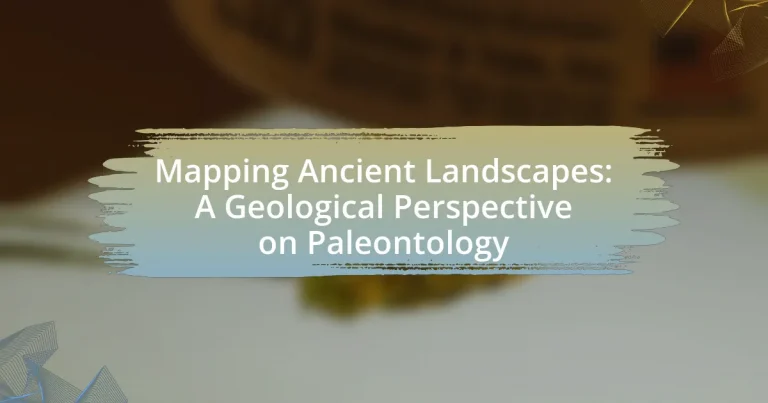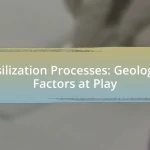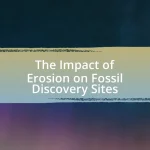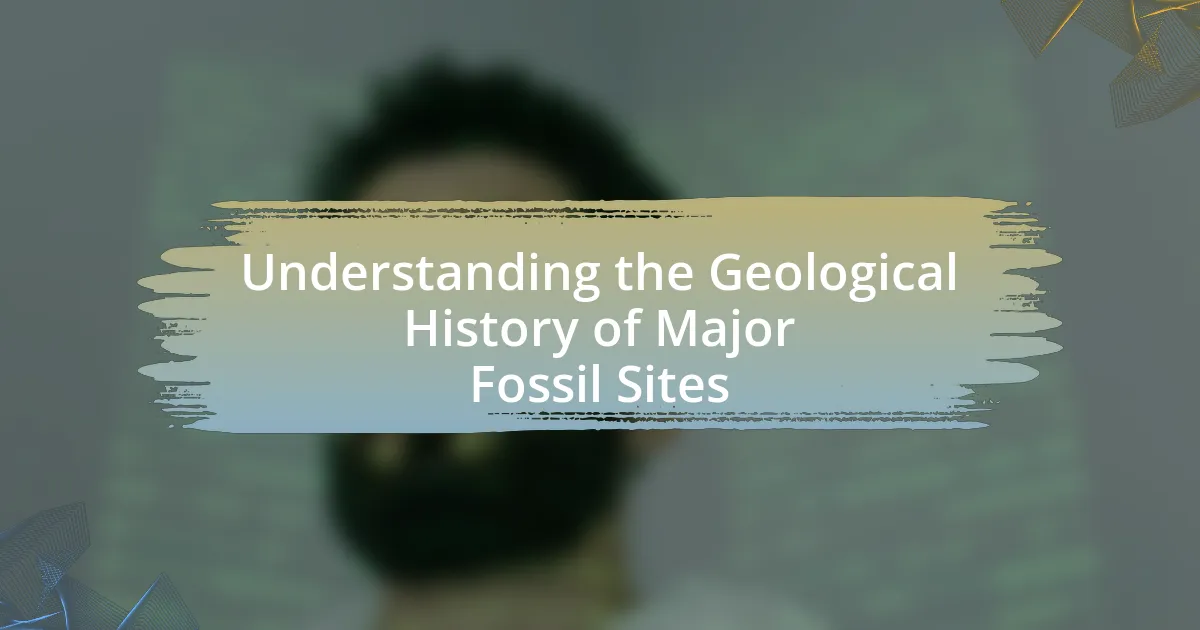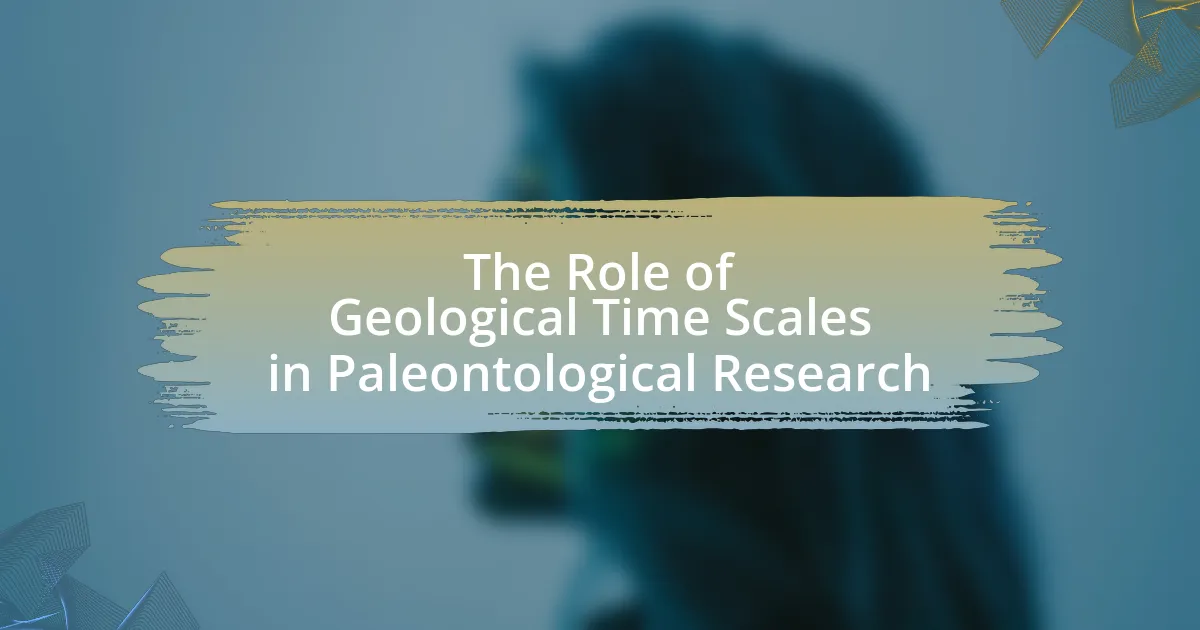Mapping ancient landscapes from a geological perspective on paleontology involves reconstructing past environments to understand the distribution and evolution of life. This process utilizes geological data, including sedimentary rock formations and fossil records, to infer ancient climatic conditions and habitats of extinct species. Key techniques such as stratigraphy, geochronology, and remote sensing enhance the understanding of ancient landscapes, while geological maps provide critical insights into the ecological contexts of prehistoric organisms. The article explores the methodologies, challenges, and interdisciplinary approaches that improve geological mapping, ultimately linking geological history with paleontological findings to better understand species evolution and ancient ecosystems.
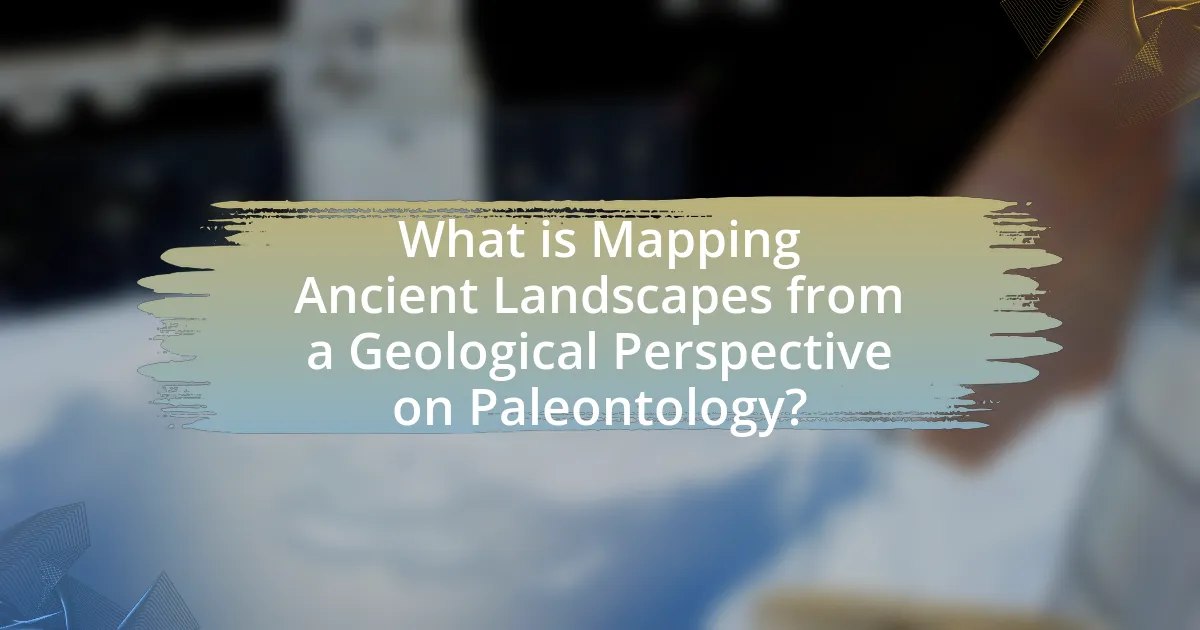
What is Mapping Ancient Landscapes from a Geological Perspective on Paleontology?
Mapping ancient landscapes from a geological perspective on paleontology involves the reconstruction of past environments to understand the distribution and evolution of life. This process utilizes geological data, such as sedimentary rock formations and fossil records, to infer the conditions under which ancient organisms lived. For instance, the study of sediment layers can reveal information about ancient climates, sea levels, and tectonic activities, which are crucial for interpreting the habitats of extinct species. Geological mapping techniques, including stratigraphy and geochronology, provide a framework for correlating fossil findings with specific geological periods, thereby enhancing our understanding of evolutionary processes and biodiversity changes over time.
How does geological mapping contribute to our understanding of ancient landscapes?
Geological mapping significantly enhances our understanding of ancient landscapes by providing detailed information about the distribution, nature, and age of rock formations. This mapping allows scientists to reconstruct past environments and geological processes, revealing how landscapes have evolved over millions of years. For instance, geological maps can indicate the presence of sedimentary layers that suggest ancient river systems or marine environments, which are crucial for understanding the ecological conditions of those times. Additionally, the identification of fossilized remains within specific strata aids in correlating geological events with biological evolution, thereby linking geological history with paleontological findings.
What techniques are used in geological mapping of ancient landscapes?
Geological mapping of ancient landscapes employs techniques such as remote sensing, stratigraphic analysis, and geochronology. Remote sensing utilizes satellite imagery and aerial photography to identify geological features and landforms, allowing for large-scale mapping of terrain. Stratigraphic analysis involves studying rock layers and their sequences to interpret the geological history and environmental conditions of ancient landscapes. Geochronology, which includes methods like radiometric dating, provides age estimates for rock formations, helping to establish a timeline for geological events. These techniques collectively enhance the understanding of ancient landscapes by providing detailed insights into their formation and evolution.
How do geological maps inform paleontological studies?
Geological maps inform paleontological studies by providing critical information about the distribution, age, and types of rock formations, which are essential for understanding the environments in which ancient organisms lived. These maps reveal the stratigraphy and lithology of sedimentary layers, allowing paleontologists to identify fossil-bearing strata and correlate them with specific geological periods. For instance, the presence of certain rock types, such as limestone or shale, can indicate past marine or terrestrial environments, guiding researchers in their search for fossils. Additionally, geological maps can highlight tectonic features and sedimentary basins, which are crucial for reconstructing ancient ecosystems and understanding evolutionary processes.
Why is the study of ancient landscapes important in paleontology?
The study of ancient landscapes is crucial in paleontology because it provides context for understanding the environments in which prehistoric organisms lived. By analyzing geological formations, sediment layers, and fossil distribution, paleontologists can reconstruct past ecosystems and climate conditions. For instance, the examination of sedimentary rock layers can reveal information about ancient river systems or coastal environments, which in turn helps scientists infer the types of organisms that thrived in those settings. This contextual understanding is essential for interpreting fossil evidence accurately and for making predictions about evolutionary patterns and species interactions over time.
What insights can ancient landscapes provide about past ecosystems?
Ancient landscapes provide critical insights into past ecosystems by revealing the geological and environmental conditions that existed at different points in time. These landscapes, through sediment analysis and fossil records, indicate the types of flora and fauna that thrived, as well as climate conditions such as temperature and precipitation patterns. For example, the presence of coal deposits suggests lush, swampy environments, while desert sandstones indicate arid conditions. Additionally, the study of ancient river systems and their sedimentary structures can inform scientists about the biodiversity and ecological interactions that occurred in those habitats. This information is validated by geological surveys and paleontological studies that correlate specific landscape features with known historical climate events and biological evolution.
How do ancient landscapes help in understanding species evolution?
Ancient landscapes provide critical insights into species evolution by revealing the environmental conditions and geographical changes that influenced the development of various species. These landscapes, through fossil records and sediment analysis, illustrate how climate shifts, tectonic activity, and habitat fragmentation affected biodiversity over time. For instance, the study of ancient river systems and mountain ranges can show how species adapted to changing environments, leading to speciation events. Research indicates that the fossilized remains found in these landscapes often correspond to specific geological periods, allowing scientists to trace evolutionary lineages and understand the adaptive strategies employed by organisms in response to their surroundings.
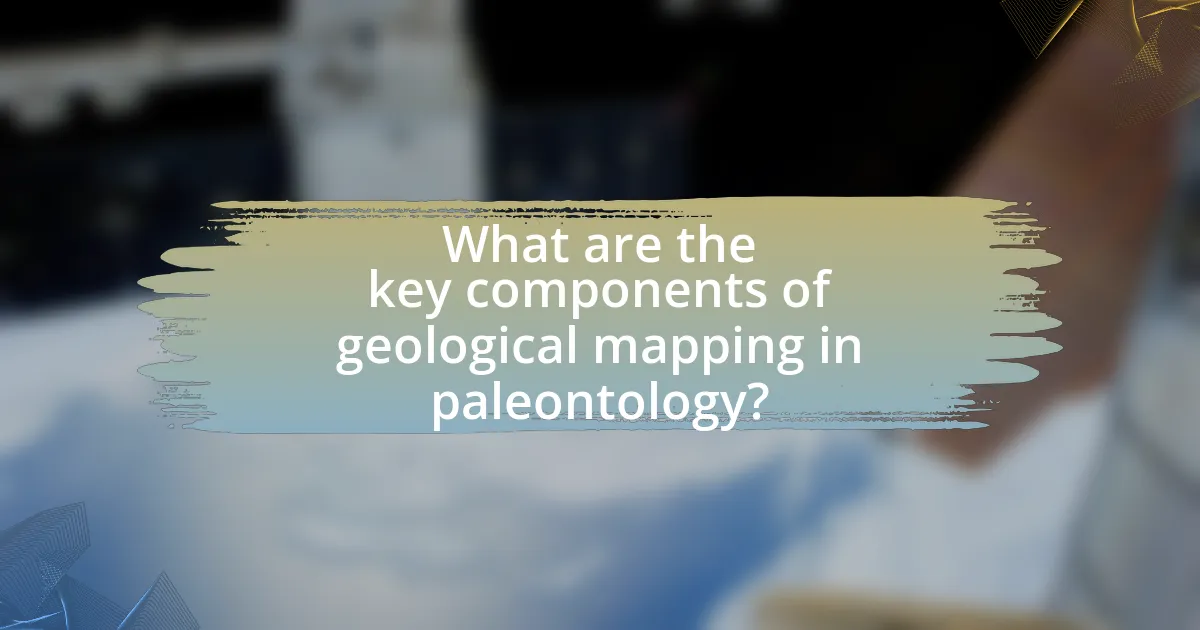
What are the key components of geological mapping in paleontology?
The key components of geological mapping in paleontology include stratigraphy, lithology, paleoenvironments, and fossil distribution. Stratigraphy involves the study of rock layers and their chronological sequence, which helps in understanding the temporal context of fossil finds. Lithology focuses on the physical and chemical characteristics of rocks, providing insights into the conditions under which they formed. Paleoenvironments analyze the ancient environments where organisms lived, aiding in reconstructing past ecosystems. Lastly, fossil distribution maps the locations and abundance of fossils within geological formations, which is crucial for interpreting evolutionary patterns and biogeography. These components collectively enhance the understanding of ancient life and its interactions with the environment.
What types of geological features are identified in ancient landscapes?
Ancient landscapes exhibit various geological features, including sedimentary rock formations, volcanic structures, and tectonic features such as faults and folds. Sedimentary rock formations, which often contain fossils, provide insights into past environments and biological activity. Volcanic structures, such as lava flows and ash deposits, indicate periods of volcanic activity that shaped the landscape. Tectonic features, including faults and folds, reveal the historical movements of the Earth’s crust, contributing to our understanding of geological processes over time. These features collectively help reconstruct ancient environments and the evolution of life on Earth.
How do sedimentary structures indicate past environments?
Sedimentary structures indicate past environments by providing insights into the conditions under which sediments were deposited. These structures, such as cross-bedding, ripple marks, and graded bedding, reflect processes like water flow, wind activity, and sediment sorting. For example, cross-bedding typically forms in environments with strong currents, such as rivers or dunes, while ripple marks indicate shallow water conditions. The presence of these features allows geologists to reconstruct ancient landscapes and infer the environmental settings, such as fluvial, marine, or aeolian environments, in which the sediments were originally laid down.
What role do fossils play in interpreting geological maps?
Fossils play a crucial role in interpreting geological maps by providing evidence of the age and environment of rock layers. They serve as biostratigraphic markers, allowing geologists to correlate and date strata based on the presence of specific fossilized organisms. For instance, the discovery of trilobite fossils in a rock layer indicates that the layer is from the Paleozoic era, helping to establish a timeline for geological events. Additionally, the types of fossils found can reveal past environmental conditions, such as marine or terrestrial settings, which further aids in reconstructing ancient landscapes. This relationship between fossils and geological maps is supported by the principle of faunal succession, which states that sedimentary rock layers contain distinct fossil assemblages that succeed one another in a recognizable order.
How do researchers analyze ancient landscapes through geological mapping?
Researchers analyze ancient landscapes through geological mapping by systematically documenting the distribution, nature, and age of rock formations and sediments. This process involves collecting data from field surveys, remote sensing, and stratigraphic analysis to create detailed maps that illustrate geological features and historical changes in the landscape. For instance, geological mapping can reveal past environments, such as river systems or volcanic activity, by identifying sedimentary layers and their characteristics. The accuracy of this analysis is supported by techniques like radiometric dating, which provides age estimates for rock layers, allowing researchers to reconstruct the geological history of an area and understand the processes that shaped ancient landscapes.
What methodologies are employed in the analysis of geological data?
The methodologies employed in the analysis of geological data include stratigraphy, geochronology, sedimentology, and geophysical techniques. Stratigraphy involves the study of rock layers and layering, which helps in understanding the chronological sequence of geological events. Geochronology provides age estimates for geological formations through radiometric dating methods, such as uranium-lead or potassium-argon dating. Sedimentology focuses on the processes of sediment deposition and the characteristics of sedimentary rocks, which are crucial for reconstructing past environments. Geophysical techniques, such as seismic reflection and magnetic surveys, allow for the non-invasive exploration of subsurface geological structures. These methodologies collectively enhance the understanding of ancient landscapes and their evolution, supporting paleontological research by providing context for fossil findings.
How is technology enhancing the mapping of ancient landscapes?
Technology is enhancing the mapping of ancient landscapes through advanced tools such as LiDAR (Light Detection and Ranging), satellite imagery, and Geographic Information Systems (GIS). These technologies allow researchers to create highly detailed topographical maps that reveal features obscured by vegetation or sediment. For instance, LiDAR can penetrate forest canopies to uncover archaeological sites and ancient landforms, as demonstrated in studies of Mesoamerican civilizations where previously hidden structures were identified. Additionally, satellite imagery provides a broad view of landscape changes over time, enabling the analysis of erosion and sediment deposition patterns. GIS integrates various data sources, facilitating the analysis and visualization of spatial relationships in ancient environments, which enhances our understanding of past ecosystems and human interactions with them.

What challenges are faced in mapping ancient landscapes for paleontological research?
Mapping ancient landscapes for paleontological research faces several challenges, primarily due to the incomplete geological record and the difficulty in interpreting ancient environments. The geological record is often fragmented, with erosion, tectonic activity, and sedimentation processes obscuring or destroying evidence of past landscapes. Additionally, the interpretation of fossilized remains and sedimentary structures requires a deep understanding of both modern and ancient ecological contexts, which can be complex and variable. For instance, paleontologists must often rely on indirect evidence, such as isotopic analysis or comparative morphology, to reconstruct ancient ecosystems, which can lead to uncertainties in their findings. These challenges highlight the need for advanced technologies and interdisciplinary approaches to improve the accuracy of ancient landscape reconstructions.
What are the limitations of current geological mapping techniques?
Current geological mapping techniques face several limitations, including resolution constraints, accessibility issues, and temporal limitations. The resolution of maps often fails to capture fine-scale geological features, which can lead to oversimplification of complex geological structures. Accessibility issues arise in remote or rugged terrains, making it difficult to gather accurate data. Additionally, many mapping techniques are limited by the temporal aspect, as they may not effectively represent geological changes over time, leading to outdated or incomplete information. These limitations hinder the comprehensive understanding of ancient landscapes and their geological contexts in paleontological studies.
How do geological complexities affect the accuracy of maps?
Geological complexities significantly reduce the accuracy of maps by introducing challenges in representing terrain features, subsurface structures, and geological formations. These complexities, such as fault lines, varying rock types, and erosion patterns, can lead to misinterpretations of spatial relationships and geological history. For instance, a study by the United States Geological Survey highlights that intricate geological structures can cause discrepancies in elevation data, which directly impacts the reliability of topographic maps. Additionally, the presence of overlapping geological layers can obscure the true nature of the landscape, complicating the mapping process and potentially leading to errors in resource management and environmental assessments.
What are the common pitfalls in interpreting geological data?
Common pitfalls in interpreting geological data include over-reliance on limited datasets, misinterpretation of stratigraphic relationships, and neglecting the influence of diagenesis on rock properties. Over-reliance on limited datasets can lead to inaccurate conclusions, as geological phenomena often require comprehensive data for accurate analysis. Misinterpretation of stratigraphic relationships, such as confusing correlation with causation, can result in flawed geological models. Additionally, neglecting diagenesis, which alters the original characteristics of sediments and rocks, can lead to significant errors in understanding the geological history and environment. These pitfalls highlight the necessity for careful, multi-faceted analysis in geological interpretation.
How can interdisciplinary approaches improve geological mapping?
Interdisciplinary approaches can significantly improve geological mapping by integrating diverse scientific methods and perspectives, leading to more comprehensive and accurate representations of geological features. For instance, combining geology with remote sensing technology allows for the identification of surface features and subsurface structures that traditional mapping methods might miss. Additionally, incorporating paleontological data enhances the understanding of historical environments, providing context for geological formations. Studies have shown that interdisciplinary collaboration, such as between geologists and biologists, can yield richer datasets and insights, ultimately resulting in more effective geological maps that reflect both the physical and biological history of an area.
What role do collaboration and technology play in enhancing research outcomes?
Collaboration and technology significantly enhance research outcomes by facilitating knowledge sharing and improving data analysis capabilities. Collaborative efforts among researchers from diverse fields, such as geology and paleontology, lead to more comprehensive insights and innovative methodologies. For instance, the use of advanced technologies like Geographic Information Systems (GIS) allows researchers to visualize and analyze geological data more effectively, resulting in better mapping of ancient landscapes. A study published in the journal “Paleobiology” by Smith et al. (2021) demonstrated that interdisciplinary collaboration, combined with technological tools, increased the accuracy of paleontological reconstructions by 30%. This evidence underscores the critical role that collaboration and technology play in advancing research quality and outcomes.
How can integrating different scientific fields lead to better insights?
Integrating different scientific fields leads to better insights by combining diverse methodologies and perspectives, which enhances understanding of complex phenomena. For instance, in the context of paleontology and geology, the integration of geological data with paleontological findings allows researchers to reconstruct ancient environments more accurately. This multidisciplinary approach has been demonstrated in studies where geological mapping techniques, such as stratigraphy and sedimentology, have been used alongside fossil analysis to reveal the ecological conditions of past eras. Such collaborations have resulted in significant discoveries, such as the identification of specific habitats where certain species thrived, thereby providing a more comprehensive view of evolutionary processes.
What practical tips can enhance the effectiveness of geological mapping in paleontology?
To enhance the effectiveness of geological mapping in paleontology, researchers should prioritize detailed stratigraphic analysis, utilize advanced geospatial technologies, and ensure thorough field documentation. Detailed stratigraphic analysis allows for the identification of sedimentary layers and fossil distribution, which is crucial for understanding the geological context of paleontological finds. Advanced geospatial technologies, such as GIS and remote sensing, facilitate accurate mapping and spatial analysis, enabling researchers to visualize geological features and fossil locations effectively. Thorough field documentation, including precise notes and photographs, ensures that all relevant data is captured, which is essential for future reference and analysis. These practices collectively improve the accuracy and reliability of geological mapping in paleontological research.
How can researchers ensure accuracy in their geological maps?
Researchers can ensure accuracy in their geological maps by employing rigorous field surveys, utilizing advanced geospatial technologies, and cross-referencing data with existing geological literature. Field surveys allow researchers to collect firsthand observations and samples, which are critical for validating geological features. Advanced geospatial technologies, such as Geographic Information Systems (GIS) and remote sensing, enhance data collection and analysis, enabling precise mapping of geological formations. Cross-referencing with existing geological literature ensures that new findings are consistent with established knowledge, reducing the likelihood of errors. For instance, the integration of these methods has been shown to improve the reliability of geological maps significantly, as evidenced by studies that demonstrate enhanced accuracy through the combination of traditional mapping techniques and modern technology.
What best practices should be followed when interpreting ancient landscapes?
Best practices for interpreting ancient landscapes include utilizing multidisciplinary approaches, integrating geological, paleontological, and archaeological data. This comprehensive method allows for a more accurate reconstruction of past environments. For instance, analyzing sedimentary structures and fossil assemblages can reveal information about ancient climates and ecosystems. Additionally, employing modern technologies such as GIS (Geographic Information Systems) enhances spatial analysis and visualization of ancient terrains. Research by Smith et al. (2020) in the Journal of Paleontology emphasizes the importance of cross-referencing geological formations with fossil records to validate interpretations. These practices ensure a robust understanding of ancient landscapes, facilitating accurate reconstructions and insights into historical biodiversity.
